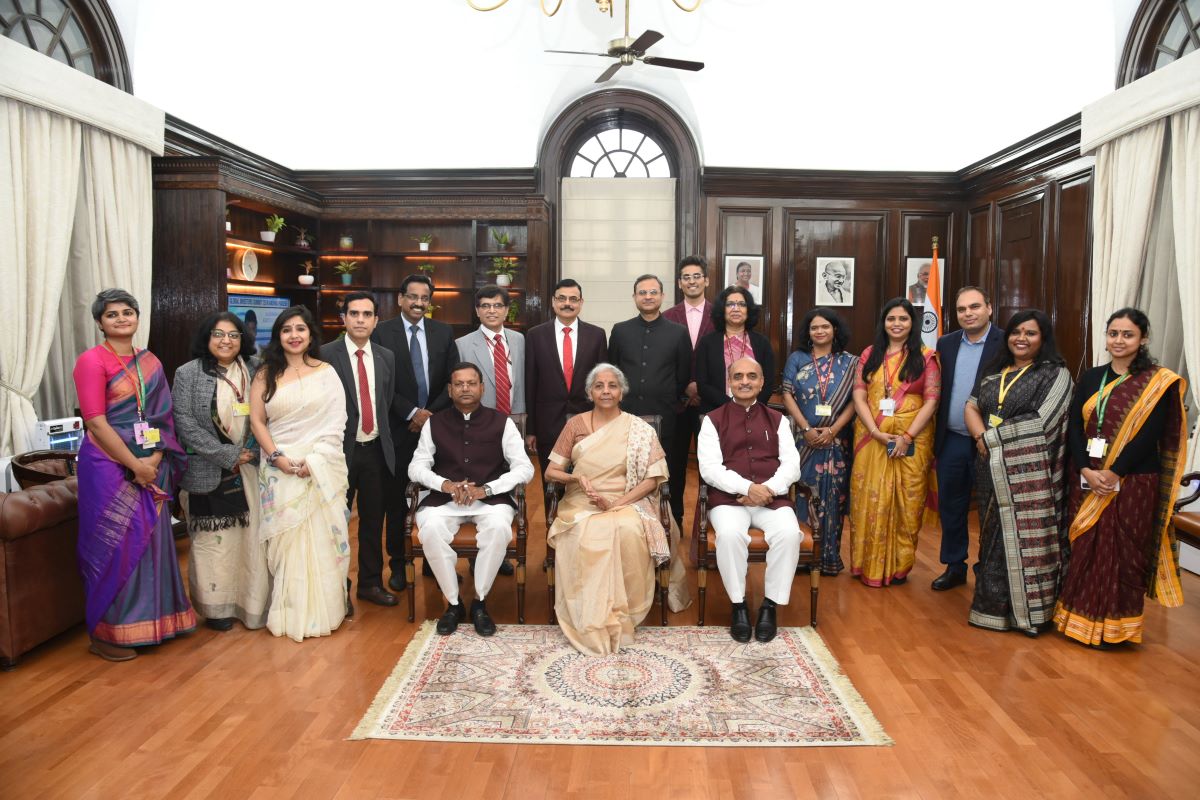The National Digital Library for Children and Adolescents — again something not related to fisc or money — is an encouraging move. It should be extended further to higher education level, making available titles that are out of reach for many involved in academic research.

Union Finance Minister Nirmala Sitharaman with the Budget 2023 team (Twitter/nsitharaman) ,
Union Budget presentations have always led to at least two different general reactions: One looking for proposals and taxation; and the other, a dismissal of the exercise as not being relevant to the daily lives of ordinary citizens.
Increasingly, the Budget has moved towards what it should be — a statement of account of the government with broad policy statement and intent. Reduced rhetoric, a focus on the revenue, fiscal side and immediate policy needs, and mostly not pandering to various interest groups have been the route Finance Minister Nirmala Sitharaman has taken over the years. She has been consistent with it this year too, though this happens to be the last complete Budget before the 2024 general elections.
That said, there are points that are important at macro level and need to be highlighted
On the non-economic aspects too, if one can call them that, there are a few that deserve attention. In this article, we would like to bring them up without throwing too many numbers since the live presentations and interactions have already done them.
With the world coming to a grind due to the Covid-19 related lockdown, and businesses and investment taking a hit, the government had stepped up its spending.
For the third year in a row, the government has increased the capital investment outlay. The increase in the latest budget is 33 percent to ₹10 lakh crore, three times the size of the outlay made in the financial year 2019–20.
For the second year, the Budget specifically mentions the aim is to crowd-in private investments. That means the government wants its expenditure — be it on roads, infrastructure, and railways — to propel private investments.
For various reasons, private investments have remained muted over many years. For overall economic growth and job creation, that has to happen.
As Sitharaman explained at the press conference, last year’s target on capital expenditure has been met to the extent of 97 percent. So there may not be many doubts about the current year’s outlay being exercised.
So far, the Covid-19 related efforts from the fiscal side to vaccines have kept India ahead of many nations. One might ask how much of this gets reflected in employment figures.
Formalisation through EPFO numbers have increased, though one cannot say that alone would reflect the service, farm, and unorganised sector labour market post-Covid. There could be a problem if private investments do not pick up as expected or some more of the global headwinds impact our calculations.
States, many a time — especially the ones that are ruled by non-BJP parties — would pose the question: What is there in the Budget for us?
It is natural for opposition-ruled states to do so.
The Budget did not have any specific mentions of state allocations or projects except for one-off ones, and a large assistance of ₹5,300 crore for the Upper Bhadra irrigation project in poll-bound Karnataka.
The finance secretary said the government scheme of capital expenditure support to states has been utilised last year almost close to the outlay. That should indicate that the states have indeed worked well to make use of the scheme.
This year too, the 50-year interest-free loan to state governments has been extended “to spur investment in infrastructure and to incentivise them for complementary policy actions”.
The outlay has been increased to ₹1.3 lakh crore. States and cities will be encouraged to undertake urban planning reforms and actions to transform our cities into “sustainable cities of tomorrow”.
We often hear about cooperative federalism when talking about Centre-state relations. Many schemes from infrastructure to social sector projects need this.
In practice, we have seen even opposition-party ruled states that have been at loggerheads politically with the Centre doing well in working together on such projects.
Like the Smart Cities and the earlier JNNURM programmes, the current outlays also come with certain conditions on governance and implementation. On paper, the conditions may sound harsh.
There is a scheme to incentivise cities to be creditworthy to raise municipal bonds. The conditions for accessing the ₹10,000 crore annual allocation under the Urban Infrastructure Development Fund (UIDF) again may come under criticism.
As mentioned earlier, from the JNNURM days, the Centre has made this effort to get reforms reach the level of municipalities to make them financially independent and raise funds on their own creditworthiness.

From a natural cavern in between the Badami cave temples 2 and 3 (6th century CE). The Agasthya Theertha and three structural temples on the other side of the hill are visible. Not far away is the UNESCO world heritage site of Pattadakkal (Prasanna RS)
There is a good focus on tourism in Budget 2023. The upsurge in tourist footfalls after Covid encourages one to focus further on the service sector with a focus on employment generation.
Here again, the Centre and states have to work together to achieve the objectives. The FM also mentioned in her speech that “promotion of tourism will be taken up on mission mode, with active participation of states, convergence of government programmes, and public-private partnerships”.
We do not know the fine-print of the schemes. but from what we see happening over rail connectivity, improvement of railway stations, air connectivity, and highways, the macro picture is clear.
Southern states in particular should do very well on tourism. One hopes tangible programmes are put in place quickly.
Tamil Nadu has been seeing record tourism arrivals. The southern states, particularly Tamil Nadu and Karnataka, have important world heritage sites, and numerous monuments and temples. They can do even better when it comes to the tourism sector.
Last-mile work has to be done by the local bodies, in terms of upkeep of sites, providing clearances for hotels, resorts, conveniences, cleanliness etc.,
The 50 destinations to be selected again works on a competitive mode like Smart Cities.
The effect of concerted work on 50 destinations can be pretty huge. It takes into account micro-details and the importance of developing the places as a complete package.
The IRCTC tour packages do cater to domestic tourism requirements. The tourism circuits and low-cost initiatives can work well. A word of caution: What is needed is sustainable tourism without endangering the heritage sites or eco-diversity.
The mention of mangroves, Ramsar sites, and wetland ecosystems in Budget 2023 gives one hope that the sustainability factor would be kept in mind while implementing tourism projects and related infrastructure.
It is indeed heartening that the number of Ramasar sites in India has gone up from 26 in 2014 to 75 now. The Budget also mentioned local communities and their conservation efforts.
“The government will promote their unique conservation values through Amrit Dharohar, a scheme that will be implemented over the next three years to encourage optimal use of wetlands, and enhance biodiversity, carbon stock, eco-tourism opportunities and income generation for local communities,” the FM said in her speech.
If it is followed in word and spirit, this will encourage a crucial sector that has been seeing high-value tourism in the last decade.

The mangroves of Muthupet, part of the Point Calimere area, which was the only Ramsar site in Tamil Nadu till 2021 (Prasanna RS)
There was a question during the post-Budget press conference about a particular weave from Assam getting a GI and what special incentives would there be to support weavers.
There are enough schemes, the FM said, and indeed there are — such as the Unity Mall spelt out in this Budget to already existing initiatives of one district, one product.
There is still a long way to go in ensuring these products get a wider reach, getting the GI its due, and not letting GI just remain a tag and a recognition.
A lot of efforts have to come in from craft groups, NGOs, and SHGs too to make this big.
When there was a lot of pressure on the government to hand out cash liberally during the Covid lockdown, it spent money tactically and not lavishly.
It did keep the country in good stead compared to many other nations. Distribution of free food grain to all Antyodaya households did work and it has been continued for another year.
Though the announcement was already made, the allocation finds mention in the Budget, keeping the social sector objectives clear. The Centre will bear a total expenditure of ₹2 lakh crore towards free food grain distribution.
The PM Awas Yojana has worked well in building homes, especially in rural areas. The programme has seen a 66 percent hike in the Budget to ₹79,000 crore. This again benefits all the states.
Extending the social sector reach to specific groups, the vulnerable tribal groups scheme has been announced with a ₹15,000 crore allocation for the next three years.
In the world of economics and numbers, these might matter little.
But to the large number of arts, crafts, and unbelievable diversity in textiles, it matters that there is recognition and focus on the artisan group.
The PM Vishwakarma Kaushal Samman has designed an assistance package for the artisan group to help in improving quality, and also in brand promotion and marketing.
The number of people in this unorganised sector alone is enough reason to put our heart and soul in making this succeed. India is almost unique in having old handmade textiles and craft traditions alive, and such measures are needed to keep them vibrant.
The National Digital Library for Children and Adolescents — again something not related to fisc or money — is an encouraging move. It should be extended further to higher education level, making available titles that are out of reach for many involved in academic research.
An announcement on ‘Bharat Shared Repository of Inscriptions’ not only gladdens the heart of heritage enthusiasts but is also a very constructive move towards helping history writing with authority. The first stage of the Digital Epigraphy Museum project targets digitisation of one lakh ancient inscriptions.
Finally, we have talked about judicial reforms and jail reforms, and recently the President had also raised the issue in one of her speeches. It is humanitarian and necessary for the state to extend assistance to poor prisoners, and Budget 2023 has promised financial support to them over penalties and the bail amount.
(MC Vaijayanthi has spent a major part of her career as a journalist covering stock markets, banking, finance, oil and gas sector for various national and international media organisations. She was a Panos South Asia fellow in 2012–13 as part of their India Telecom Project)

Feb 21, 2023

Feb 17, 2023

Feb 16, 2023

Feb 09, 2023

Feb 07, 2023

Feb 07, 2023